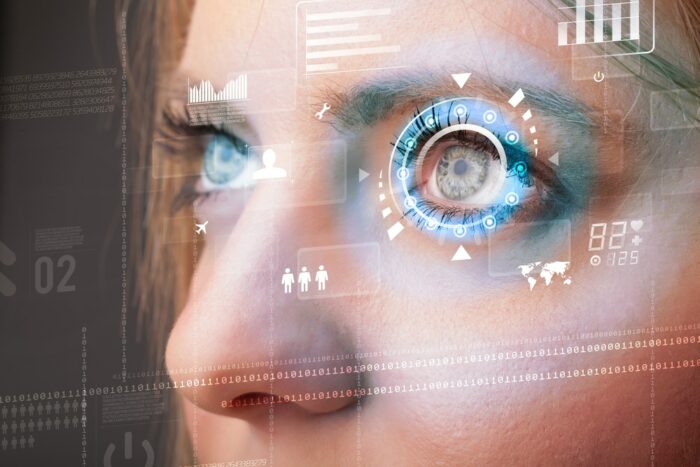
The Future of Augmented Reality in Physical Security
Augmented reality (AR) is an emerging technology, but it is emerging on a grand scale and, in the security industry, experts are already analysing how it will impact the landscape, and it seems there is much to be excited about. Here we look at a selection of areas in which physical security could benefit from AR technology, as well as touching on what the future could hold.

What is Augmented Reality?
Augmented reality is a real world view of a live, physical environment where the elements are augmented by computer-generated information, such as images, text, video, sound or GPS data. Whilst originally, this computer-generated information was viewed through a headset or AR glasses, more and more, people are using apps on their smartphones to access the augmented view.
Augmented reality is not to be confused with virtual reality, which places the user in a simulated world. AR simply expands the sensory experience of the real world with overlaid information.
An example of AR would be a consumer walking down an unfamiliar street, using a smartphone app to overlay information on the surrounding environment, so that they could instantly see where the likes of shops, services or places of interest were. The same technology could be used to bring up reviews of restaurants in the area, or find out the history of a landmark.
How can AR be used in physical security?
AR has a growing number of beneficial uses in the physical security sector.
Augmented reality for locksmiths and security engineers
Using AR, locksmiths and engineers are able to view things onsite they would never be able to see on a simple diagram, such as floor plans.
For example, say there is an electronic lock that has stopped working. The wiring diagrams can be called up and superimposed over the door, helping the engineer ascertain much faster where the problem could potentially lie, making repairs and maintenance a much more efficient process.
The same concept could be used to plan wiring for CCTV and intruder alarm systems.
Think of AR as X-ray vision, providing the ability to see through walls and floors. With AR, security engineers can see network cables, pipes and other hidden equipment. Live and archived video can be brought up too and overlaid onto any feature of a property, assisting enormously with installation planning.
Photo and video capture
Augmented reality also makes it possible for security professionals to digitally transmit images and video footage back to a central location in real time.
So, as they walk through an assessment, the engineer can not just record vital information, they can actually share that information with others in real time, taking advantage of remote additional advice or a second opinion where needed. This is ideal for training, as well as for complex situations that call for added higher level input.
Video surveillance and augmented reality
Modern CCTV cameras used in surveillance already have the ability to provide live views of forensic quality, allowing operators to effectively monitor and assess situations and respond in real time to developing situations. Now imagine the added benefit that AR-powered overlaid information will bring.
There are surveillance cameras already on the market with the ability to overlay street names and compass points on live video footage, providing valuable assistance with accurate directions. This is particularly useful where seconds can make all the difference, for example directing people to the nearest defibrillator, or guiding crowds to the nearest safe exit in an evacuation situation.
What is the future of Augmented Reality in security?
It is not difficult to imagine a world where the lines between AR and true reality are blurred. Combining existing and live data has the ability to bring vital insight in a security environment, whether to engineers, or first responders.
It would be impossible at this point to overlook the coming of the ‘Metaverse’, a term that is currently buzzing around the world of technology. With the Metaverse and its immersive user experience, a world of opportunities lies ahead. Tipped to become the next internet, the Metaverse is a network of virtual worlds; a shared digital place where people meet, travel and collaborate, without leaving their personal location. And it’s already happening.
Meta Horizon Workrooms is a virtual meeting space where co-workers of the organisation formerly known as Facebook can join a virtual meeting – as avatars – using AR headsets.
Now bring this into the world of security, where future trends predict a more cohesive relationship between physical and cyber security management. Security engineers, cyber security consultants and health and safety and facilities managers could all meet remotely, ‘at a property’ yet in the virtual world, to consult together and devise a holistic strategy to comprehensively safeguard that property, using insightful data and information that would have traditionally taken hours and hours of collation time.
Heading into the future with Barry Bros Security
Ever since we first started serving the people of London with security services over seven decades ago, we’ve always stayed on top of emerging trends here at Barry Bros Security. Now, as technology evolves, and we look to harness the power of an extended reality, we are very excited about how the security landscape could potentially benefit from augmented reality and all the Metaverse has to offer. Watch this space!
In the meantime, for all the latest security solutions for your home or business, you are welcome to get in touch for tailored advice, or pay a visit to our London showroom to browse our extensive product range.
The post The Future of Augmented Reality in Physical Security appeared first on Barry Bros Security.
This content was originally published here.


